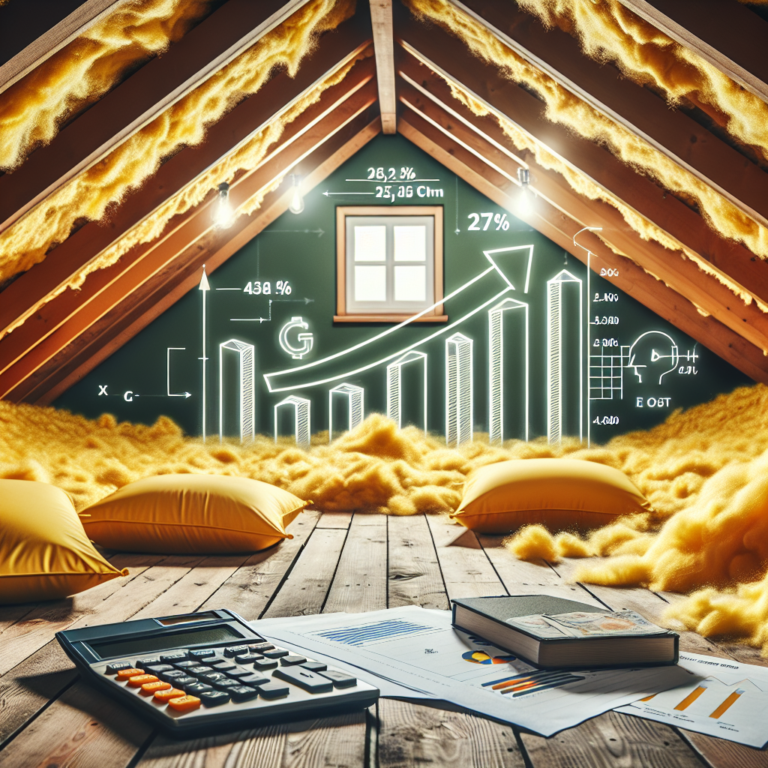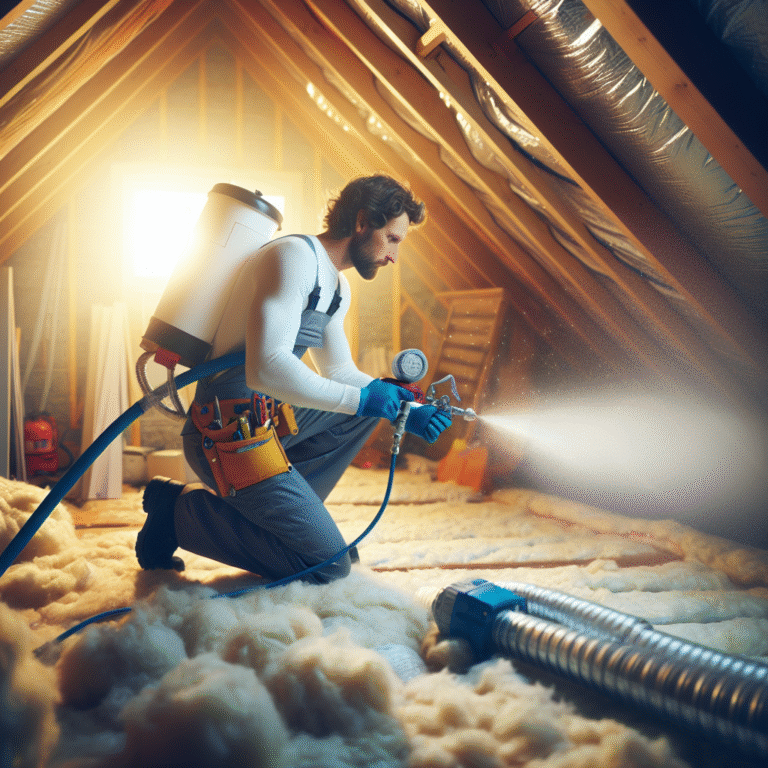-
Table of Contents
Seal in the savings and the environment with Blown-In Insulation – the eco-friendly choice for energy-efficient homes.
Upgrade your home’s energy efficiency with blown-in insulation. Say goodbye to high energy bills and hello to a greener solution. Visit texasinsulationsolution.com to learn more and schedule your installation today.”
Introduction
Blown-in insulation is a type of insulation that is becoming increasingly popular as a green solution for energy-efficient homes. It involves using loose, lightweight materials such as cellulose, fiberglass, or mineral wool to fill in the gaps and crevices in walls, attics, and other areas of a home. This method of insulation not only helps to reduce energy consumption and lower utility bills, but it also has a positive impact on the environment by reducing carbon emissions. In this way, blown-in insulation is a sustainable and eco-friendly option for homeowners looking to make their homes more energy-efficient.
Benefits of Cellulose Insulation for Energy Efficiency
In today’s world, where environmental concerns are at the forefront of many discussions, it is important to consider the impact of our homes on the planet. One way to make our homes more environmentally friendly is by improving their energy efficiency. This not only reduces our carbon footprint but also saves us money on energy bills. One solution that has gained popularity in recent years is blown-in insulation, specifically cellulose insulation. In this article, we will explore the benefits of cellulose insulation for energy efficiency in homes.
cellulose insulation is made from recycled paper products, making it a sustainable and eco-friendly option. It is treated with fire-retardant chemicals, making it safe for use in homes. This type of insulation is blown into walls, attics, and other spaces using specialized equipment, filling in gaps and creating a seamless layer of insulation. This method of installation allows for a more thorough coverage, reducing the chances of air leaks and heat loss.
One of the main benefits of cellulose insulation is its high R-value. R-value is a measure of an insulation material’s ability to resist heat flow. The higher the R-value, the more effective the insulation is at keeping heat in during the winter and out during the summer. cellulose insulation has an R-value of 3.6-3.8 per inch, which is higher than other types of insulation such as fiberglass or foam. This means that cellulose insulation provides better thermal resistance, making it a more energy-efficient option for homes.
Another advantage of cellulose insulation is its ability to reduce air infiltration. Air infiltration is the movement of air through small cracks and gaps in a home’s structure. This can lead to drafts, uneven temperatures, and higher energy bills. cellulose insulation is blown into walls and other spaces, filling in these gaps and creating a tight seal. This not only improves energy efficiency but also helps to reduce noise from outside and improve indoor air quality.
cellulose insulation is also a cost-effective option for homeowners. While the initial cost of installation may be slightly higher than other types of insulation, the long-term savings on energy bills make it a worthwhile investment. The high R-value and air sealing properties of cellulose insulation mean that homeowners can save up to 20% on their energy bills. Additionally, the use of recycled materials in cellulose insulation makes it a more affordable option compared to other types of insulation.
Furthermore, cellulose insulation is a green solution for energy-efficient homes. As mentioned earlier, it is made from recycled paper products, reducing the amount of waste that ends up in landfills. It also requires less energy to produce compared to other types of insulation, making it a more sustainable choice. By choosing cellulose insulation, homeowners can reduce their carbon footprint and contribute to a healthier planet.
In addition to its energy efficiency benefits, cellulose insulation also has fire-retardant properties. The insulation is treated with chemicals that make it resistant to fire, providing an added layer of safety for homeowners. This is especially important in areas prone to wildfires or for homes with wood-burning fireplaces.
In conclusion, blown-in cellulose insulation offers numerous benefits for energy-efficient homes. Its high R-value, ability to reduce air infiltration, cost-effectiveness, and eco-friendliness make it a top choice for homeowners looking to improve their home’s energy efficiency. With the added benefits of fire-retardant properties and noise reduction, it is clear that cellulose insulation is a green solution for a more sustainable and comfortable home.
The Environmental Impact of Green Insulation
Insulation is an essential component of any home, providing a barrier against heat loss and gain. However, traditional insulation materials such as fiberglass and foam can have a negative impact on the environment. This is where blown-in insulation comes in as a green solution for energy-efficient homes.
The environmental impact of traditional insulation materials is primarily due to their production process. Fiberglass, for example, is made from sand and recycled glass, which requires a significant amount of energy to melt and spin into fibers. This process also releases harmful chemicals into the air, contributing to air pollution. Foam insulation, on the other hand, is made from petrochemicals, which are non-renewable resources and emit greenhouse gases during production.
In contrast, blown-in insulation is made from recycled materials such as cellulose, fiberglass, and mineral wool. These materials are sourced from post-consumer waste, such as newspapers, cardboard, and denim, making blown-in insulation a sustainable option. By using recycled materials, blown-in insulation reduces the amount of waste sent to landfills and decreases the demand for new resources.
Moreover, the production process of blown-in insulation is less energy-intensive compared to traditional insulation materials. The recycled materials are shredded and treated with non-toxic chemicals to make them fire-resistant and insect-repellent. This process requires less energy and does not release harmful chemicals into the environment.
Another significant environmental benefit of blown-in insulation is its ability to reduce energy consumption in homes. By providing a more effective barrier against heat loss and gain, blown-in insulation helps to maintain a consistent temperature inside the house. This means that homeowners can rely less on heating and cooling systems, resulting in lower energy consumption and reduced carbon emissions.
Furthermore, blown-in insulation is a more durable option compared to traditional insulation materials. Fiberglass, for example, can settle and compress over time, reducing its effectiveness. On the other hand, blown-in insulation is blown into the walls and attics, filling any gaps and creating a more airtight seal. This not only improves energy efficiency but also helps to prevent drafts and moisture from entering the home, reducing the risk of mold growth.
In addition to its environmental benefits, blown-in insulation also has financial advantages for homeowners. While the initial cost of installation may be slightly higher than traditional insulation materials, the long-term savings on energy bills make it a cost-effective option. According to the Department of Energy, homeowners can save up to 20% on heating and cooling costs by properly insulating their homes.
Moreover, blown-in insulation is a non-toxic and non-irritating option for homeowners. Traditional insulation materials, such as fiberglass, can release tiny particles into the air, which can be harmful if inhaled. Blown-in insulation, on the other hand, is made from natural and recycled materials, making it a safer option for both the environment and homeowners.
In conclusion, blown-in insulation is a green solution for energy-efficient homes. Its use of recycled materials, less energy-intensive production process, and ability to reduce energy consumption make it an environmentally friendly option. Additionally, its durability, cost-effectiveness, and non-toxic properties make it a practical choice for homeowners. By choosing blown-in insulation, homeowners can not only improve the energy efficiency of their homes but also contribute to a healthier and more sustainable environment.
How Blown-In Insulation Can Save You Money on Energy Bills
Blown-in insulation is a popular and effective method for insulating homes, especially for those looking for a green and energy-efficient solution. This type of insulation involves blowing loose fibers or particles into walls, attics, and other spaces to create a barrier against heat transfer. Not only does it provide excellent insulation, but it can also save homeowners money on their energy bills.
One of the main benefits of blown-in insulation is its ability to reduce energy consumption. By creating a barrier against heat transfer, it helps keep the warm air inside during the winter and the cool air inside during the summer. This means that your heating and cooling systems don’t have to work as hard to maintain a comfortable temperature, resulting in lower energy bills.
In addition to reducing energy consumption, blown-in insulation also helps to improve the overall energy efficiency of a home. This is because it can fill in any gaps or cracks in the walls or attic, preventing air leaks and drafts. These air leaks can account for up to 30% of a home’s energy loss, so by sealing them with blown-in insulation, homeowners can significantly improve their home’s energy efficiency.
Another way blown-in insulation can save you money on energy bills is by reducing the need for constant heating or cooling. With traditional insulation, the temperature inside a home can fluctuate, causing the heating or cooling system to turn on and off frequently. This constant cycling can lead to higher energy bills. However, with blown-in insulation, the temperature inside the home remains more consistent, reducing the need for the heating or cooling system to constantly turn on and off.
Furthermore, blown-in insulation is a more cost-effective option compared to other types of insulation. It is relatively easy and quick to install, which means homeowners can save on labor costs. Additionally, blown-in insulation is made from recycled materials, making it an environmentally friendly and affordable option.
Moreover, blown-in insulation can also save homeowners money in the long run. By reducing energy consumption and improving energy efficiency, it can increase the value of a home. This is because potential buyers are often attracted to energy-efficient homes, knowing that they will save money on energy bills in the future. So, not only does blown-in insulation save you money on energy bills, but it can also be a wise investment for the future.
Aside from its cost-saving benefits, blown-in insulation also has a positive impact on the environment. As mentioned earlier, it is made from recycled materials, reducing the amount of waste that ends up in landfills. Additionally, by reducing energy consumption, it helps to lower carbon emissions, making it a more sustainable option for homeowners.
In conclusion, blown-in insulation is a green and energy-efficient solution for homes. It can save homeowners money on energy bills by reducing energy consumption, improving energy efficiency, and reducing the need for constant heating or cooling. It is also a cost-effective option and has a positive impact on the environment. So, if you’re looking to save money on energy bills and make your home more energy-efficient, consider blown-in insulation as a green solution.
Q&A
1) What is blown-in insulation?
Blown-in insulation is a type of insulation material that is installed by blowing it into walls, attics, or other spaces using specialized equipment. It is typically made of recycled materials such as cellulose, fiberglass, or mineral wool.
2) How does blown-in insulation help make homes more energy-efficient?
Blown-in insulation helps make homes more energy-efficient by creating a barrier that prevents heat from escaping in the winter and entering in the summer. This reduces the amount of energy needed to heat or cool a home, resulting in lower energy bills and a smaller carbon footprint.
3) Is blown-in insulation considered a green solution?
Yes, blown-in insulation is considered a green solution because it is made from recycled materials and helps reduce energy consumption. It also has a longer lifespan compared to other types of insulation, reducing the need for frequent replacements and further reducing waste.
Conclusion
In conclusion, blown-in insulation is a green and effective solution for creating energy-efficient homes. It offers numerous benefits such as reducing energy consumption, lowering utility bills, and improving indoor air quality. Additionally, it is made from recycled materials and has a long lifespan, making it an environmentally friendly choice. With the increasing focus on sustainability and energy conservation, blown-in insulation is a smart and eco-friendly option for homeowners looking to make their homes more energy-efficient.




